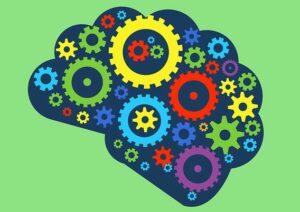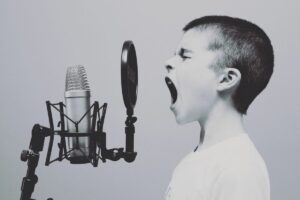1. WHAT IS AUTISM SPECTRUM DISORDER AND WHERE DOES IT COME FROM ?
Autism Spectrum Disorder (ASD) is not a disease but a neurodevelopmental disorder. This means that its characteristics are present from a young age and persist throughout a person’s life. ASD leads to highly variable difficulties from one person to another, which impact daily life and hinder social integration.
The traits and challenges associated with ASD affect the individual’s functioning on several levels:
- Social interactions,
- Communication,
- Behavior
- Interest

Various management methods can help reduce certain symptoms, but a person with ASD will never “recover” in the way one might recover from an illness.
The exact causes of autism are not well understood, but it is known that multiple factors contribute to its development rather than a single cause.
Recent research has shown that autism has a strong genetic component : genetic markers have been associated with an increased risk of developing ASD, and parents (whether autistic or not) who carry these markers can pass them on to their children. Additionally, it is sometimes observed that multiple siblings in a family may be on the autism spectrum.
Scientists are also exploring potential environmental factors, but these are still unclear. Exposure to certain chemicals in utero or some prenatal infections may increase the risk of a child developing ASD.
Did you know ?
As autism is still not fully understood, the classification of the disorder changes rapidly. For example, in the DSM-4, Rett syndrome was classified as autism, but not in the DSM-5.
Here are the diagnostic criteria defined by the DSM-V :
- Persistent deficits in social communication and social interaction in multiple contexts
- Restricted and repetitive patterns of behavior, interests and activities.
Persistent deficits in social communication and interaction include, for example :
- difficulties in interpreting emotions (one’s own and those of others) and facial expressions,
- difficulty grasping pictorial expressions,
- difficulties in grasping second-degree or tacit social rules,
- inability or difficulty in modulating communication according to context or interlocutor,
- an inability to adapt to a conversation by restarting it, reformulating, etc,
- a deficit in non-verbal communication,
- difficulties in developing, maintaining and understanding age-appropriate social relationships.
In terms of behavior, autistic people are intolerant of change:

- They need daily routines and repetition, such as motor stereotypies (repetitive behaviors that are reassuring to autistic people; rocking, hand movements, etc.).
- Many autistic people have a particular sensory perception:
- hypersensitivity to certain stimuli and hyposensitivity to others
- sometimes an unusual interest in sensory elements of the environment (a fascination with lights or spinning objects, for example).
- People with ASD are more often prone to synesthesia (the act of associating two or more senses with each other: associating colors with musical notes or numbers, for example) than the rest of the population.
Symptoms must be present in early childhood (but may not be fully manifest as long as social demands do not exceed limited capacities). This set of symptoms results in clinically significant limitations in social, occupational or other spheres of functioning in daily life.
The etiology of autism is not yet well understood, but we do know that there is a combination of factors, rather than a single cause.
2. WHAT ARE THE DIFFERENT FORMS OF ASD AND ITS COMORBIDITIES ?
Because autism spectrum disorder is a spectrum, it is extremely broad. That’s why the DSM-V diagnostic criteria include three “levels of functioning”, each defining the support needed by a child or adult diagnosed with an autism spectrum disorder:
- Level 1: requires support.
- Level 2: requires a high level of support.
- Level 3: requires a very high level of support.
These levels of support reflect differences in the day-to-day difficulties encountered by people with autism.
Level 1 corresponds to what used to be called “high-functioning autism”

These are people who will develop speech normally, or even more rapidly than children their age. Moreover, the quality of their language may be more sustained and developed than the norm for their age group. Asperger’s syndrome falls into this category.
This type of autism is characterized by the absence of intellectual deficits (i.e., an IQ above 70). As a result, there may be people with high or very high intellectual potential among them. The person is therefore able to manage daily tasks such as eating and dressing independently.
On the other hand, repetitive and restricted behaviors, difficulties in adapting to change, and social difficulties are significant and disabling.
In this type of autism, however, these difficulties may not be immediately apparent. Nevertheless, there are dysfunctions in executive functions (planning, organization, etc.).
People with level 2 ASD will have greater or more obvious verbal and social communication problems than those diagnosed with level 1.
Executive function disorders are also present, and learning difficulties (dys disorders) are often noted. Level 2 autistic children tend to have very narrow interests and adopt repetitive behaviours that may prevent them from functioning in certain situations.
Level 3 is what we used to call “low-functioning autism”, which includes, for example, Kanner-type autism. This is the most severe type of autism, and the one that is most present in the collective imagination when we talk about autism.
People at this level need the most support, including full-time aids or intensive therapy. Some autistic people on this level of the spectrum are non-verbal and sometimes totally incapable of the slightest social interaction.
The comorbidities of ASD are numerous:
- ADHD
- Mood disorders (depression, bipolar)
- Anxiety disorders (Generalized Anxiety Disorder, Social Anxiety Disorder, OCD)
- Intellectual disability (IQ <= 70)
- Global developmental delay, psychomotor disorders
Although autism is not a disease, certain types of therapy/medication can help manage specific symptoms or comorbidities. These include:
- Medication treatment (can help with ADHD, mood or anxiety disorders)
- Psychological therapy tailored to the specific needs of autistic people
- Psycho-motor or occupational therapy sessions
- Speech therapy, which can be very important in cases of associated dysfunction, selective mutism or non-verbal autism.
3. HOW TO SPOT AN ASD IN MY CHILD
Each child develops at his or her own pace and doesn’t always follow general medical curves and predictions: this is not necessarily worrying or predictive of any disorder. If you’re a parent, you’re in the best position to see persistent non-acquisition of behaviors or skills, or regression (a skill that used to be acquired and is no longer – this often happens with autistic children).
Here are the main signs of autism in very young children (under 2). If you notice these signs in your child, it’s important to discuss your concerns with a paediatrician: the earlier autism is diagnosed, the more effective the child’s care will be, and the better he or she will integrate into society.
In France, diagnoses can be made by the CRA (Centre Ressource Autisme), which are free and specialized, but the wait is often very long. The other solution is to see a psychiatrist, either in private practice or in a center specializing in autism.
Reduced/absent eye contact
Researchers have found that infants/children with ASD show an early decline in eye contact, with a shifty gaze.
Decreased/absent non-verbal communication
Infants/children with ASD have limited non-verbal communication (no hand-waving, no pointing at objects or people, little or no stretching of arms, etc.).
Mimics
The child has few facial expressions.
Emotional state
Infant very (too) calm or, on the contrary, too agitated. Infant cries all the time or never cries.
Difficulty sleeping
The child has difficulty sleeping, sleeping very little for an infant/child of his age.
Limited imitation
Children diagnosed with autism are often deficient in imitation.
First name
The child has little or no response to his first name.
Sensitivity
Sensory hypersensitivity and/or sensory hyposensitivity
Regression in children is typical of autism, usually occurring before the age of 2. The child loses one or more previously acquired skills (loss of speech, for example).
Here are the main signs of autism in children :
- Seemingly uninterested in other children: preference for solitary play, limited socialization attempts, limited response to others’ socialization attempts, avoidance of social situations
- Difficulty understanding and managing emotions, difficulty understanding the emotions of others (this sign is often mistaken for a lack of empathy, but this is often not the case).
- Little use of body language
- Little or no response to first name
- Inappropriate play with toys (e.g., lining up cars instead of rolling them)
- Stereotypies (repetitive movements such as hand flapping)
- Intolerance to change, need for routines
- Intense tantrums, aggression
- Language delay or above-average language development
- Lack of social reciprocity (doesn’t respond to people, doesn’t bounce back from conversations, etc.)
- Marked clumsiness
- Difficulty playing pretend or group games
- Dislikes being touched and/or cuddled
- Difficulty understanding irony, second degree, humor
- Implicit social codes not acquired
- Wants to impose rules all the time (reassuring for autistic people)
- Strong attachment to objects
Here are the main signs of autism in adolescents (in addition to those mentioned above) :
- May take an obsessive interest in a particular subject, spending hours talking about it and seeking information about it.
- Doesn’t seem to notice when the other person isn’t interested in what he’s saying.
- Has a very good vocabulary
- Speaks too formally
- Difficulty organizing, planning
- Difficulty making age-appropriate friends, prefers younger people or adults
- Can’t adjust vocabulary or behavior to social situations
- Difficulty sleeping
- Anxiety
- Eating disorder
- School phobia
If you notice these signs in yourself, don’t hesitate to consult your doctor: autistic parents are more prone to parental burn-out.
In children and adolescents, their differences, their difficulty in communicating with other children and making themselves understood, and their hypersensitivity can lead to school phobia.
4. MEANS OF CARE
A variety of methods can be used to help autistic children and adults become more independent. The following methods are recommended by the French National Authority for Health (HAS):
- Educational therapies, based on applied behavior analysis : ABA (Applied Behaviour Analysis), based on behavioural sciences. The principle is to develop or reinforce a behavior using various techniques (chaining, etc.) and to modify inappropriate behaviors. Appropriate behaviours are rewarded and praised, while inappropriate behaviours are not, which encourages the child to abandon them.
- TEACCH (Treatment and Education of Autistic and related Communication handicapped Children). The aim of this learning method is to encourage the autistic person’s autonomy, by providing an environment structured into zones and personalized teaching using different scenarios. The scenarios are often in pictures, structured with start and end times.
To be effective, these interventions must be personalized, i.e. defined on the basis of an initial assessment of the child, and constantly re-evaluated and adapted. These are intensive methods: at least 20 hours of practice per week are required, with the HAS even recommending a minimum of 25 hours per week.
In reality, however, it is quite complicated for families to access care, as there is a lack of professionals trained in these methods in France. As a result, specialized centers and professionals are overcrowded, and waiting lists to access them are very long. The role of parents is paramount: parents and professionals are co-actors. At home, learning methods must be maintained.
- Exchange and development therapies (TED), which aim to develop functions that autistic children lack through stimulation and play: the idea is not to impose but to propose interaction, and to encourage and congratulate the child when he or she participates in an exchange.
- Cognitive-behavioral therapies (CBT): CBT can help identify specific socially maladaptive behaviors and implement strategies to reduce or replace them with more appropriate ones. They can also teach autistic people to better manage their emotions and anxiety, for example with the AWARE method.
